Physical Address
304 North Cardinal St.
Dorchester Center, MA 02124
Reduction rhinoplasty has been the main objective for the majority of cosmetic rhinoplasties performed in Caucasians over many decades. Rhinoplasty experts today have a much better understanding of the intricate relationships between anatomic changes and rhinoplasty outcomes than previous generations of nasal surgeons. Although Aufricht's observation that rhinoplasty is “an easy operation to do, but it is hard to get good results” still holds true, the end results of cosmetic nasal operations have become more predictable. Modern aesthetic goals for a normal looking nose have made today's “reduction rhinoplasty” a different operation than it was just 25 years ago. The goals of patients who are interested in cosmetic rhinoplasty reflect these modern insights. Today, patients specifically ask not to have pinched, scooped-out, or upturned noses, common consequences of older rhinoplasty techniques. Our informed patients are looking for better looking and better functioning noses devoid of signs of prior surgery. The request for a smaller nose is as commonplace today as it was in the past. The majority of primary rhinoplasty patients are concerned that their noses are too big. Only the nuanced discussion during the consultation will reveal that “too big” of today is not the “too big” of the past; it may simply mean poor tip definition or a nasal hump. Even African Americans or Asians who will benefit from augmentation rhinoplasty may describe their noses as large, for lack of a better descriptor. If used judiciously and honestly, preoperative photoanalysis and computer photoimaging can add value to the educational preparation for the patient and clarity for the surgeon.
“A nose that is too big for the patient's face” is our definition of the large nose. We consider a nose large if the tip is overprojected and the dorsum is too high. Given these characteristics, the large nose is almost exclusively encountered in Caucasian patients. Commonly, other related issues need attention for a balanced outcome, including rotation and refinement of the tip, width of the nasal vault, and configuration of the alar base. Although a variety of bony and soft tissue facial dimensions have been established to describe facial size and proportions, most experienced rhinoplasty surgeons rarely use exact measurements to analyze a nose before rhinoplasty. It is rather their aesthetic sense and experience that most surgeons use to prepare for the operation. This “eye” of the rhinoplasty surgeon for what looks good reflects his or her knowledge of ideals in facial angles and dimensions, personal judgment, and aesthetic goals. A woman, for instance, with a prominent nose and receding chin may benefit from both reduction rhinoplasty and chin enhancement. It depends on her other facial characteristics, ethnicity, body habitus and height, as well as the surgeon's own aesthetic sense and biases. A surgeon's bias is rarely discussed as affecting their rhinoplasty result, but it is clear that a surgeon practicing in southern California often has a very different goal for their female rhinoplasty patient than if he or she had been practicing in New York. A surgeon's judgment is colored by the demands of what patients have requested over years of practice mixed with their own definition of beauty.
Requests for correction of the large nose are commonly encountered in patients of southern European and Middle Eastern decent. Assessment of the large nose hinges on overall facial proportions, and the patient's stature, race, and gender. Men have more robust nasal features than women. The rotation of the male tip (90 to 95 degrees) should be less than the female (95 and 110 degrees). A tall and athletic man benefits from a nose that is on the large end of the spectrum of male aesthetics. A nose that is too small for a tall man will appear more unnatural and worse than a larger nose. For a petite woman, on the other hand, a rather small and delicate nose with tip rotation at the upper end of normal may appear just right.
Although experienced rhinoplasty surgeons rely on their judgment when considering overall nasal proportions, they also incorporate established norms in their nasal analysis.
As measured from the nasion to the tip-defining point, nasal length should approximate one-third of the height of the face from hairline to menton ( Figure 24-1 ).
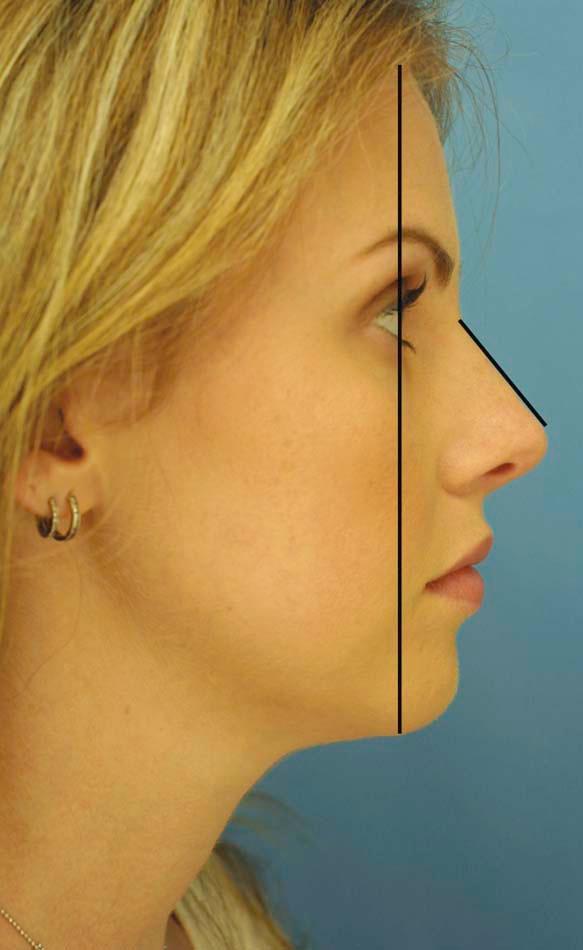
The radix, or root, of the nose is a synonym for the nasion, the gentle depression where the nose meets the forehead. The angle that is formed by the forehead and nose is the nasofrontal angle. It is usually between 115 and 130 degrees. Too shallow an angle creates a “Greek” nose, with the forehead sloping directly into the nasal dorsum. Another useful angle is the nasofacial angle. This angle is formed between the dorsal line and a vertical line traversing the nasion. Called the aesthetic profile angle by Jacques Joseph (who actually had a device to measure it directly) and renamed the nasofacial angle today, this angle ideally measures from 30 to 35 degrees ( Figure 24-2 ).
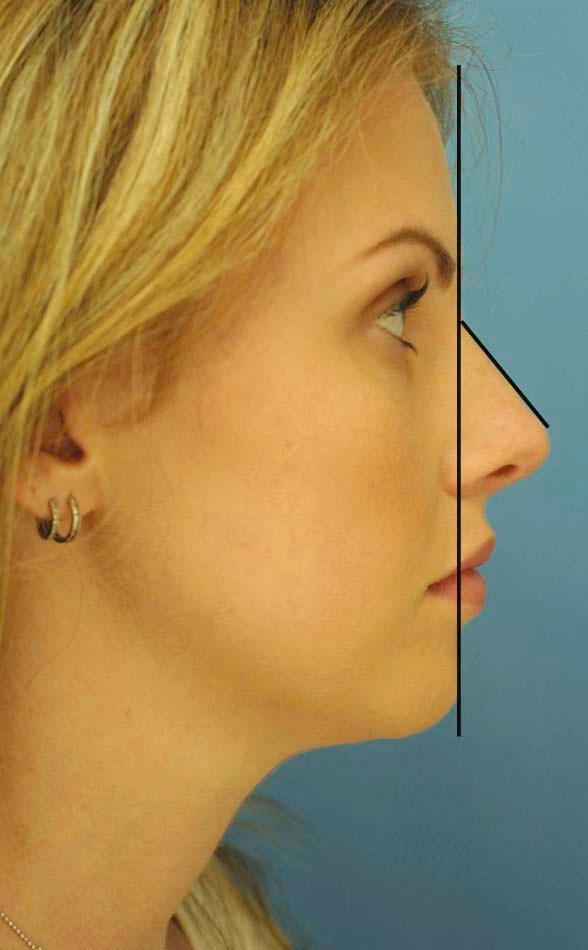
More relevant is the relative height of the radix. The ideal level lies at the upper eyelash line in women and slightly higher in men. The height of the radix directly affects nasal length: the higher the radix, the longer the nose. Today (and throughout time) a long, elegant profile is the aesthetic ideal. Adjusting the height of the radix is an important step in achieving this ideal ( Figure 24-3 ).
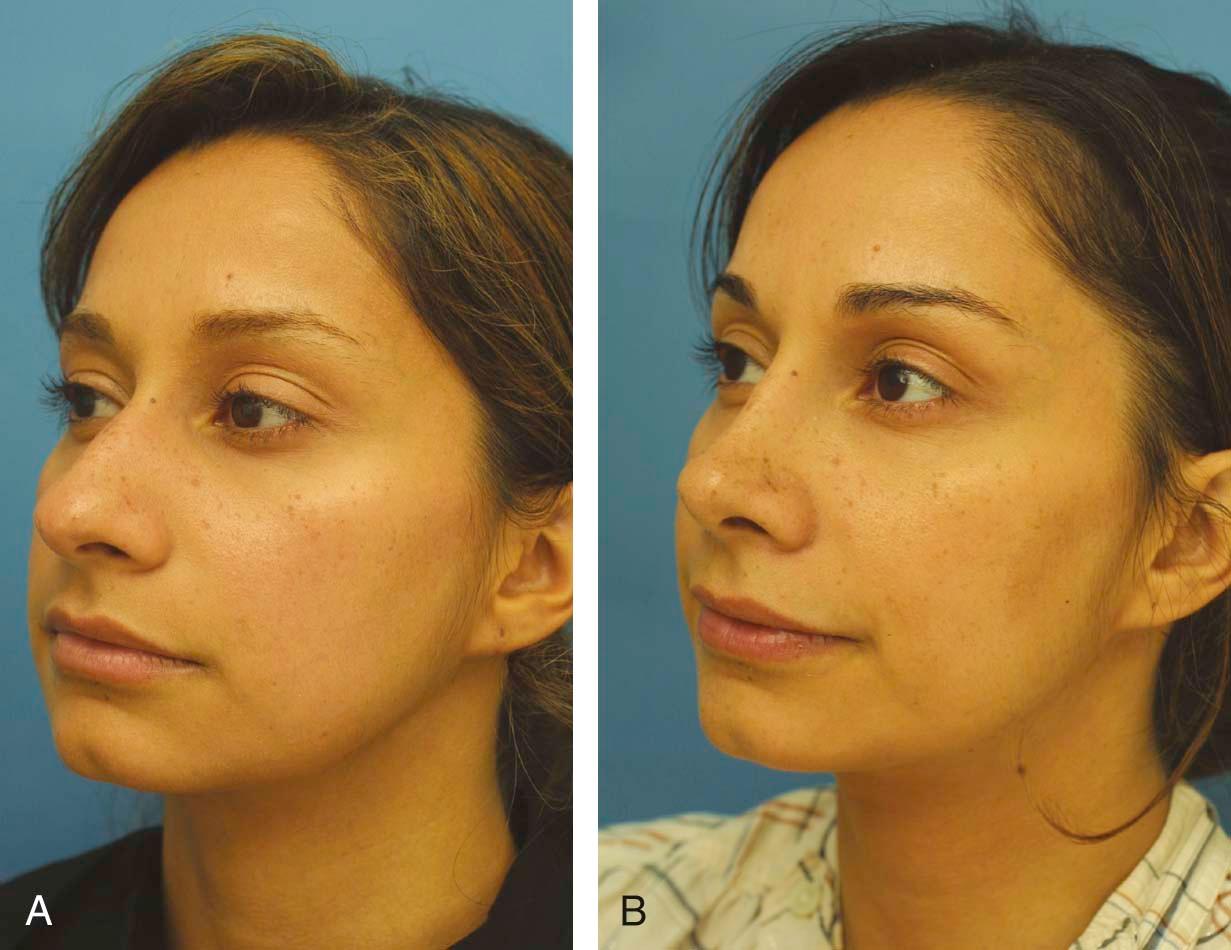
Projection of the tip is the actual measured distance from the alar–facial plane to the tip. A change in nasal projection requires either an increase or decrease in the distance the nasal tip extends from the vertical facial plane. The Goode method and the 3:4:5 triangle are the two most common ways of measuring projection.
As described by Goode, nasal projection as measured from the alar–facial crease should be 60% of nasal length. A vertical axis is drawn from nasion to alar groove intersecting a horizontal line from the alar groove to the tip. A ratio can be expressed as ala-tip–nasion-tip equaling 0.55 to 0.60. This ratio correlates well with an aesthetically balanced nasal projection ( Figure 24-4 ).
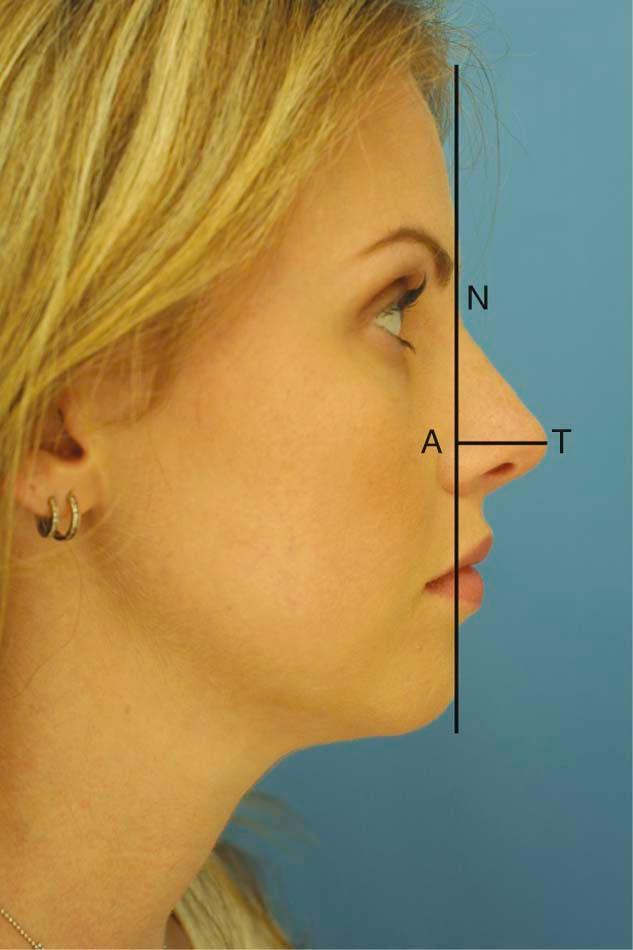
Crumley and Lanser demonstrated a relationship between nasal length and desired tip projection as forming a 3:4:5 right triangle. The vertical line is dropped from the nasion and the hypotenuse is a line drawn from the nasion to the tip. The ratio of the horizontal line (from vertical facial plane to tip) to the nasal dorsal line (hypotenuse) should be 3 : 5 or 0.60 ( Figure 24-5 ). This is in accordance with the measurements proposed by Goode.
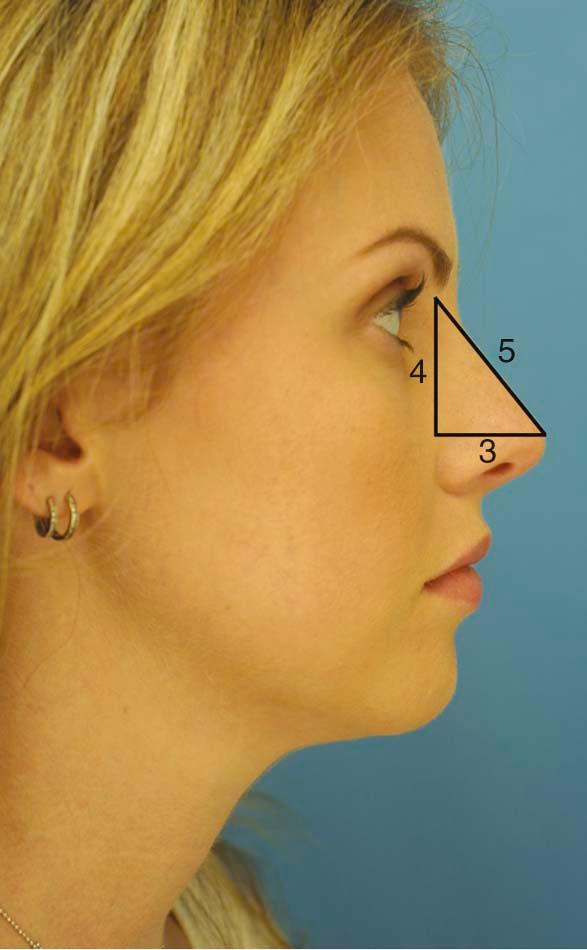
Simons describes rotation of the nasal tip as an arc with the radius maintained. As the tip is rotated, there is some illusion of increased projection, although none exists ( Figure 24-6 ). Tip rotation is defined as the tip angle from the vertical alar crease through the tip. In women this angle is approximately 105 degrees, and in men, it is 100 degrees. The degree of rotation may be affected by the intrinsic properties of the nasal tip (lower lateral cartilages) or external properties (caudal septum).
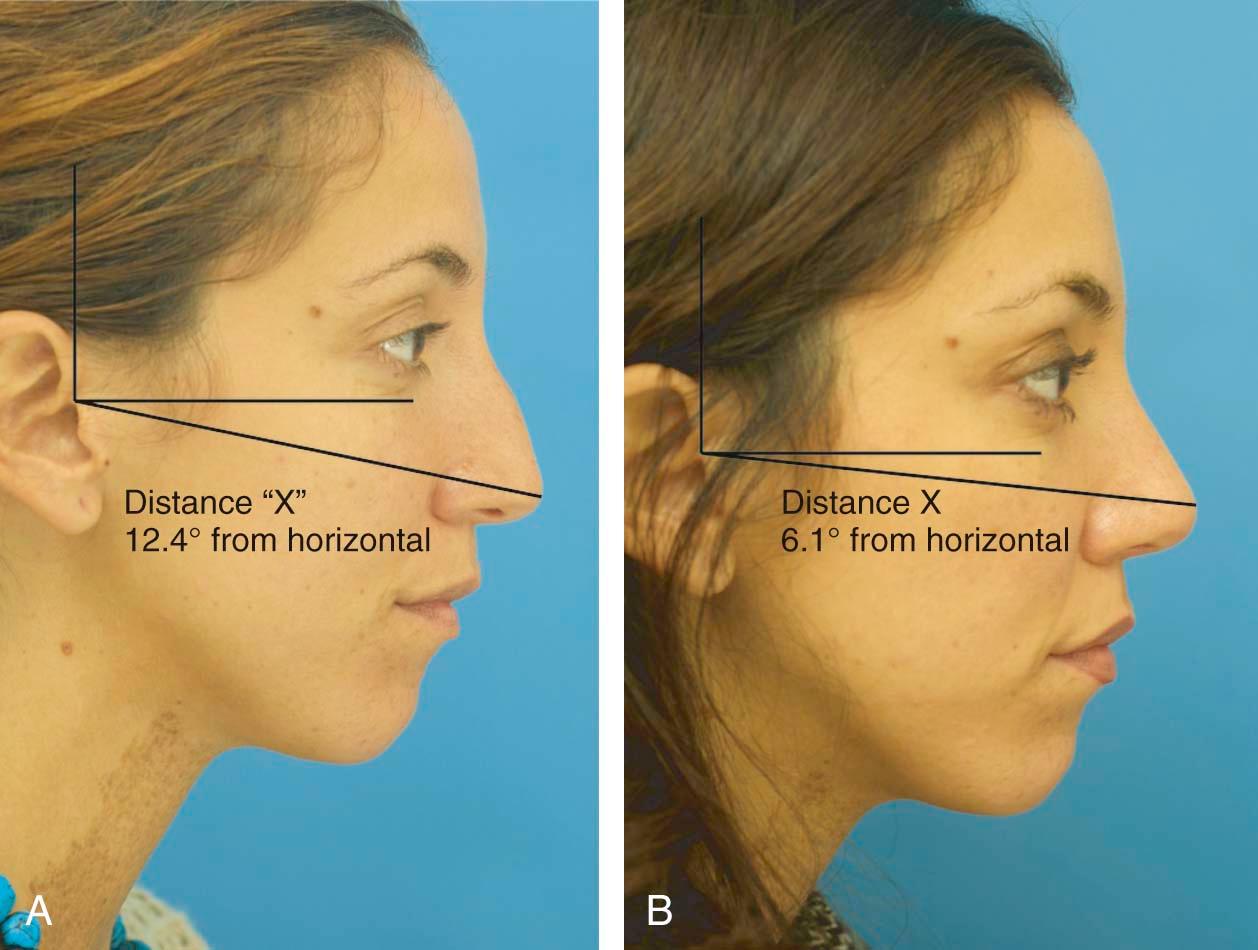
Become a Clinical Tree membership for Full access and enjoy Unlimited articles
If you are a member. Log in here